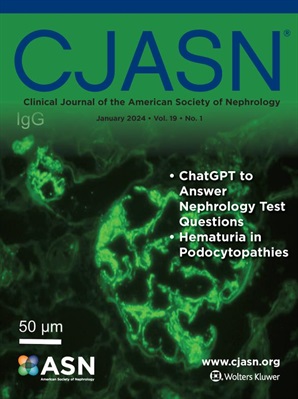Intermuscular Adipose Tissue in Chronic Kidney Disease: A Window into Muscle Quality and Health?
IF 8.5
1区 医学
Q1 UROLOGY & NEPHROLOGY
Clinical Journal of the American Society of Nephrology
Pub Date : 2025-04-30
DOI:10.2215/cjn.0000000745
引用次数: 0
Abstract
Patients with chronic kidney disease (CKD) often experience loss of muscle mass, altered muscle function, and low physical functionality, all of which contribute to increased mortality and morbidity. Mitochondrial dysfunction emerges early in the progression of CKD and may play a central role in physical dysfunction. Factors such as uremia, systemic inflammation, oxidative stress, and inappropriate activation of the renin-angiotensin-aldosterone system may play are role on mitochondrial dysfunction. On the other hand, the accumulation of ectopic adipose tissue in skeletal muscle, also known as intermuscular adipose tissue (IMAT), is a newly recognized factor in muscle function and physical performance. IMAT is a marker of muscle quality, adversely affecting local muscle function, and is associated with insulin resistance and systemic inflammation, conditions commonly observed in CKD. Nevertheless, the exact composition of IMAT and its relationship with mitochondria and muscle energetics in CKD is not fully understood. Evaluating the relationship between IMAT accumulation and mitochondrial dysfunction in CKD may unveil potential interventions to improve physical function and the quality of life of patients with CKD.慢性肾脏疾病的肌间脂肪组织:肌肉质量与健康的窗口?
慢性肾脏疾病(CKD)患者经常经历肌肉质量丧失、肌肉功能改变和身体功能低下,所有这些都导致死亡率和发病率增加。线粒体功能障碍出现在CKD进展的早期,可能在身体功能障碍中起核心作用。尿毒症、全身性炎症、氧化应激和肾素-血管紧张素-醛固酮系统的不适当激活等因素可能在线粒体功能障碍中发挥作用。另一方面,骨骼肌中异位脂肪组织的积累,也称为肌间脂肪组织(IMAT),是肌肉功能和身体表现的新认识因素。IMAT是肌肉质量的标志,对局部肌肉功能有不利影响,并与胰岛素抵抗和全身性炎症有关,这是CKD中常见的情况。然而,CKD中IMAT的确切组成及其与线粒体和肌肉能量学的关系尚不完全清楚。评估CKD中IMAT积累与线粒体功能障碍之间的关系可能揭示改善CKD患者身体功能和生活质量的潜在干预措施。
本文章由计算机程序翻译,如有差异,请以英文原文为准。
求助全文
约1分钟内获得全文
求助全文
来源期刊
CiteScore
12.20
自引率
3.10%
发文量
514
审稿时长
3-6 weeks
期刊介绍:
The Clinical Journal of the American Society of Nephrology strives to establish itself as the foremost authority in communicating and influencing advances in clinical nephrology by (1) swiftly and effectively disseminating pivotal developments in clinical and translational research in nephrology, encompassing innovations in research methods and care delivery; (2) providing context for these advances in relation to future research directions and patient care; and (3) becoming a key voice on issues with potential implications for the clinical practice of nephrology, particularly within the United States. Original manuscript topics cover a range of areas, including Acid/Base and Electrolyte Disorders, Acute Kidney Injury and ICU Nephrology, Chronic Kidney Disease, Clinical Nephrology, Cystic Kidney Disease, Diabetes and the Kidney, Genetics, Geriatric and Palliative Nephrology, Glomerular and Tubulointerstitial Diseases, Hypertension, Maintenance Dialysis, Mineral Metabolism, Nephrolithiasis, and Transplantation.

 求助内容:
求助内容: 应助结果提醒方式:
应助结果提醒方式:


